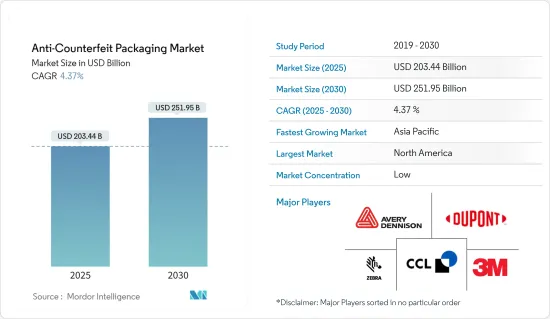Need help finding what you are looking for?
Contact Us
PUBLISHER: Mordor Intelligence | PRODUCT CODE: 1627109

PUBLISHER: Mordor Intelligence | PRODUCT CODE: 1627109
Anti-Counterfeit Packaging - Market Share Analysis, Industry Trends & Statistics, Growth Forecasts (2025 - 2030)
PUBLISHED:
PAGES: 120 Pages
DELIVERY TIME: 2-3 business days
SELECT AN OPTION
The Anti-Counterfeit Packaging Market size is estimated at USD 203.44 billion in 2025, and is expected to reach USD 251.95 billion by 2030, at a CAGR of 4.37% during the forecast period (2025-2030).

The anti-counterfeit packaging market is witnessing growth, driven by evolving regulations to safeguard life-critical products, technological strides in anti-theft measures, a diverse array of emerging threats, and an increasing emphasis on brand protection.
Key Highlights
- Regulatory measures, including the U.S.'s Anti-counterfeiting Trade Agreement and the EU Commission's labeling and serialization initiatives, are poised to bolster the market in developed economies during the forecast period.
- The surge of e-commerce has heightened the demand for anti-counterfeit packaging solutions. Online marketplaces have simplified counterfeiters' access to consumers. In response, brands are adopting advanced authentication features, like QR codes and near-field communication (NFC) tags, enabling customers to verify product authenticity via smartphones.
- Stringent regulations set by governments and regulatory bodies further fuel the market's expansion. Take the EU's Falsified Medicines Directive (FMD), which mandates unique identifiers and anti-tampering devices for all prescription medications. In China, regulations enforce track-and-trace systems for select product categories. Such mandates have catalyzed innovations in serialization technologies and secure packaging solutions.
- According to Macfarlane Group UK Ltd, in July 2024, customized anti-counterfeit packaging caters to the unique requirements of various industries. The pharmaceutical sector grapples with formidable challenges in safeguarding its products from counterfeit threats. To counteract this, consider integrating anti-counterfeit packaging features such as holographic labels, serialized QR codes, and distinct barcodes. These enhancements deter tampering and bolster product authentication, ensuring the pharmaceuticals' integrity throughout the supply chain.
- However, the market faces challenges owing to the high costs associated with setting up and innovating anti-counterfeit packaging, which deters new entrants and potential clients. Without adequate customer awareness, this hesitance and the ease of replicating existing technologies like barcodes and QR codes hamper market expansion.
Anti-Counterfeit Packaging Market Trends
Pharmaceuticals and Healthcare to Drive the Market Demand
- Counterfeit packaging for pharmaceuticals is one of the lucrative sectors of the global trade in illegally copied goods. Fake drugs harm and even kill millions of people across the world. It inflicts severe damage on the brand names of big pharmaceutical manufacturers.
Regulations Have Enabled North America to Maintain a Dominant Market Share
Anti-Counterfeit Packaging Industry Overview
Additional Benefits:
Product Code: 49217
TABLE OF CONTENTS
1 INTRODUCTION
- 1.1 Study Assumptions and Market Definition
- 1.2 Scope of the Study
2 RESEARCH METHODOLOGY
3 EXECUTIVE SUMMARY
4 MARKET INSIGHTS
- 4.1 Market Overview
- 4.2 Industry Attractiveness - Porter's Five Forces Analysis
- 4.2.1 Bargaining Power of Suppliers
- 4.2.2 Bargaining Power of Buyers
5 MARKET DYNAMICS
6 MARKET SEGMENTATION
7 COMPETITIVE LANDSCAPE
8 INVESTMENT ANALYSIS
9 MARKET OPPORTUNITIES AND FUTURE TRENDS
Have a question?


SELECT AN OPTION
Have a question?


Questions? Please give us a call or visit the contact form.
